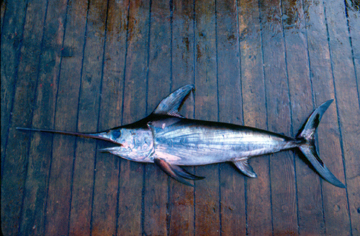Methylmercury is a nasty compound. It can damage the immune and nervous systems, and can cause severe birth defects. Fortunately, it’s rare -- we seldom come across it in our daily diets. In fact, almost all of the methylmercury in American food supplies is found in marine fish and shellfish.
 Swordfish can accumulate large amounts of methylmercury. Credit: National Oceanic and Atmospheric Administration
Swordfish can accumulate large amounts of methylmercury. Credit: National Oceanic and Atmospheric AdministrationIn the oceans, methylmercury may be created by bacteria, which convert plain mercury into this more toxic form. Larger organisms eat the bacteria, which in turn are eaten by even larger organisms, all the way up to the top predators, such as sharks and swordfish. And once it’s in their systems, it stays there for a long time, building up huge concentrations -- some of these fish have millions of times more methylmercury than the water around them.
There are no studies to tell us how much mercury and methylmercury were in the oceans decades ago, so we don’t know how much of it comes from natural sources, like volcanoes, and how much comes from industrial pollution, such as coal-fired power plants. But there’s evidence that the levels are going up, suggesting that pollution is a big part of the problem.
To avoid unnecessary risks, the USDA recommends that women who are pregnant or nursing, as well as children, limit the amount of large marine fish in their diets. In particular, they should stay away from shark, tilefish, swordfish, and king mackerel, and eat only small amounts of white tuna and other fish and shellfish. And everyone else should eat these fish in moderation -- a precaution against a nasty compound.

